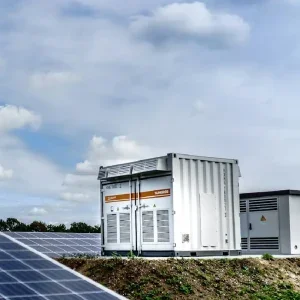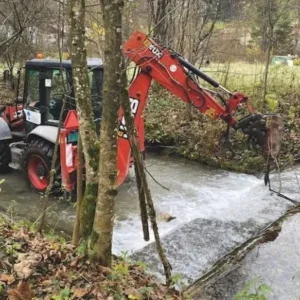FACTS (flexible ac transmission system) devices are a family of electronic systems designed to enhance controllability and increase power transfer capability. The most recent US examples of this developing technology demonstrate the work EPRI has done in the field.
Aty Edris, Electrical Power Research Institute, Palo Alto, USA
FACTS (flexible ac transmission system) devices, a family of high voltage electronic controllers and power transfer sets on a compact footprint, can increase the power carrying capacity of individual transmission lines and improve overall system reliability by reacting almost instantaneously to disturbances. Electromechanical controllers are too slow to govern the flow of alternating current in real time, resulting in loop flows and bottlenecks. By contrast a FACTS controller can react in approximately a quarter of a cycle, which is quick enough to provide real time control and enables them to increase or decrease power flow on specified lines, alleviating transmission system congestion. In addition, these controllers can enhance system reliability by counteracting transient disturbances almost instantaneously, allowing transmission lines to be loaded closer to their inherent thermal limits, effectively increasing their capacity. Although there are very few installations of such devices in the North American system, five in fact, when they are extensively deployed system operators will be able to dispatch transmission capacity within the primary interconnection regions, thus facilitating open access.
FACTS technology provides the correction of transmission functionality needed to utilise fully the existing transmission system and thereby minimise the gaps between the stability and the thermal levels. The most flexible FACTS technology is the unified power flow controller (UPFC), which has the unique ability to control independently the real and reactive power flows on transmission corridors; at the same time it provides controlled voltage support. It offers unprecedented possibilities in directing and controlling real and reactive power.
After nearly 20 years of R&D, FACTS controllers based on silicon power electronics devices are now entering utility service. Recent projects include one installation of the UPFC, a device that simultaneously controls all three aspects of power flow variability, namely phase angle, voltage regulation and line impedance. This was brought on line in 1998 at American Electric Power’s Inez substation. A more recent FACTS installation is a back-to-back (BTB) HVDC link at Eagle Pass, Texas, which provides instantaneous and continuous power transfer between the US and Mexican systems and dynamic voltage support at the two sides of the BTB.
The newest project is a convertible static compensator at the Marcy substation, NYPA, a projection resulting from computer studies that indicate that upstate-to-downstate power transfer could be improved by 240 MW, among other benefits.
Developments
The Electric Power Research Institute is sponsoring a FACTS research programme that includes hardware and software developments. The former has evolved into a full scale demonstration of FACTS controllers. The status of developed systems and those undergoing development is as follows:
• Thyristor controlled series capacitor (TCSC) line impedance controller; 208 Mvar at Slatt substation (BPA).
• Static compensator (Statcom) voltage controller, ±100 Mvar at Sullivan substation (TCVA).
• Unified power flow controller (UPFC), an all transmission parameters controller, as a ±160 MVA shunt and ±160 MVA series at Inez substation (AEP).
• Convertible static compensator (CSC) flexible multifunctional compensator; ±200 MVA at Marcy substation (NYPA). Due to come on line in 2002.
• In addition, there is the fully commercial project at Eagle Pass, Texas, a FACTS controller and 36 MVA back to back HVDC tie, (CSW).
In the software development programme, analytical and mathematical models for FACTS controllers are developed and included in EPRI digital simulation packages used to run application studies for potential users. Results have shown that installation of FACTS controllers would result in an increase in power transfer capability, with the level depending on the transmission configuration and the respective transmission constraints. Examples include:
• A transmission line in the south west of the USA boosting power flow from 300 MW to 400 MW
• Ties between southern states and Florida, increasing power flow from 3400 to 4100 MW.
• Ties between upstate New York and New York City, increasing power flow from 2600 MW to 3200 MW.
Technological challenges
The development of FACTS controllers has provided the impulse for other breakthroughs in power electronics and inverter topology. Solid state switches with greater kV and kA ratings have been developed and used in the ±100 Mvar inverter of TVA’s Statcom (Sullivan substation) and the two ±160 MVA inverters of AEP’s UPFC (Inez). The solid state switch is a gate turn off (GTO) thyristor rated at 4.5 kV and 4 kA turn off current.
To meet the high MVA ratings needed for transmission applications, a number of these modules is connected in series to constitute a switching valve. This series configuration creates a new challenge – ensuring uniform distribution of the voltage share, under steady state and transient conditions, by the individual modules in a valve. This has been solved by sensing the individual characteristics of each GTO in each valve and electronically compensating its gating command for the differences in the respective storage times so that the series GTOs in a valve turn off together.
At the heart of UPFC and Statcom technology, and the under-development CSC (convertible static compensator) is the voltage sourced inverter, VSI (see Figure 1). VSI inverts a dc voltage into a set of three phase voltages. Conversion to a sinusoidal voltage waveform itself represents a challenge. The alternative solutions currently are construction of multiple six-pulse bridges with multiple switching levels, or a single six-pulse bridge with pulse-width modulation switching. For transmission applications, which require high MVA ratings, and given the available kV and kA ratings of GTO (gate turn off) thyristors, the multiple six-pulse bridge solution is the most feasible, and has been adopted for the TVA Statcom and AEP’s UPFC. The sinusoidal waveform is obtained through an interfacing transformer known as a magnetic interface, which provides appropriate phase shifting of the output voltage of the individual six pulse bridges. (See Figure 2).
For AEP’s UPFC (Inez) a four bridge three level switching valve scheme that produces a 48 pulse voltage waveform was the selected design. Fig 3 shows the topology of the inverter and its connection to the transmission system of the shunt inverter.
UPFC
Real and reactive power transmission on a power line in an integrated network is governed by the line impedance, voltage magnitudes and phase angle difference at the transmission line ends. And the role the line is playing in maintaining network stability under dynamic contingencies.
The power transfer limits on a transmission line are in general determined by three factors:
• Thermal level – the inherent physical limit as determined by line ampacities
• Uncontrolled power flow level, the limit imposed by the natural power flow, with no secured stable dynamics
• stability level, the limit imposed by the requirements for secured, dynamically stable, power transfer.
Of these, only the third is under the control of the power provider for existing lines. Therefore power transfer in most integrated transmission systems is constrained by transient stability, voltage stability, and or power stability. These constraints limit a full utilisation of available transmission corridors. Pushing back these constraints is made possible by the UPFC, the cornerstone of FACTS technology, a device that can control simultaneously all three aspects of power flow by injecting a vectored voltage with controlled magnitude and phase angle created by the device.
The Inez project
The single UPFC project to date is the AEP’s Inez substation (see Figure 4) in eastern Kentucky. After a period of industrial growth primarily connected with coal mining the local area network has become the most heavily loaded and stressed on the AEP seven state grid system, with a power demand of 2000 MW along often overloaded 138 kV transmission lines. Single contingency outages in the area would adversely affect the underlying 138 kV system, a second contingency would be intolerable in some cases. A reliable power supply to the Inez area required effective voltage support and added real power supply facilities. To answer this need and associated computer predicted emergency scenarios, mainly the prospect of falling below 95 per cent network voltage or even second contingency area-wide blackouts in some areas, AEP built a new high capacity138 kV line between Big Sandy power plant in the Tri-State area and the Inez substation, and installed a FACTS controller to provide dynamic voltage support and to ensure full utilisation of the new line.
The installation comprises two identical three-level, 48 pulse, 160 MVA VSIs coupled to two sets of dc capacitor banks. The two inverters are interfaced with the ac system via two intermediate transformers, a set of magnetically coupled windings configured to construct a 48 pulse sinusoidal wave shape. Two identical step down shunt transformers and a single series transformer are connected to the inverters through buswork and manually operated disconnect switches (Figure 5).
Several operational modes are possible: inverter 1 can operate as a Statcom with inverter 2 operating either as a Statcom or a static synchronous compensator. With the former arrangement a shunt reactive capability of ±320 MVA would be available, sometimes necessary for voltage support in the Inez area. Usually the installation will be configured as a UPFC with the inverters connected at their dc terminals. And with one inverter down, the other can still provide reactive support.
Other major benefits are the capacity for flexible independent control of real and reactive power flow on the 950 MVA Big Sandy to Inez 138 kV line with better balancing of the summer-peaking Tri-state area and the winter peaking Inez area, improving system security in the latter and power flow to the former; re-opening of the possibilities for load growth; and reduction of real power losses by 24 MW.
The Eagle Pass BTB project
Eagle Pass is a community on the US/Mexico border served by two 138 kV transmission lines; owing to load growth the area is prone to voltage instability during peak load periods, reducing the reliability of delivery on the US side of the border. Emergency power can be brought in from Mexico over a 138 kV line but making the connection involves a switching operation that briefly interrupts power to customer loads. To mitigate voltage instability and at the same time allow power flow in either direction without disrupting supply, a back-to-back tie based on ABB’s HVDC Light technology rated at 36MVA has been installed (Figures 6-8). The alternative seemed to be the construction of a new 70 km line into the area, and with that, reliance on the shaky US grid.
BTB Light is based on the use of voltage source converter (VSC) technology to interconnect two AC systems. As compared to the conventional back-to-back using line commutated converters, this new technology doesn’t rely on the strength of the connected systems and, therefore, provides a very reliable interconnection. Furthermore, it provides the possibility of independent control of AC voltages on the two sides and the power transfer between the two AC systems.
Creation of the link was therefore both cheaper and technically more sound. BTB Light is a combination of the IGBT (insulated gate bipolar transistor) as a solid state switch, and pulse width modulation. The arrangement provides a simple and compact structure in addition to great control and operational flexibility; and does not require a specially designed magnetic interface between the Mexican and US sides. The tie is rated at 36 MVA at 138 kV. It comprises two VSCs coupled with a DC link. Each converter is connected to the respective ac grid via air core phase reactors, two shunt (6 Mvar) high pass filters and a stepdown transformer.
The tie provides unprecedented operational capability, controlled bi-directional power transfer and and voltage control at the US and mexican sides. The tie can be operated either to transfer 36 MW active power, full reactive support of 36 Mvar (Statcom function) at the two ends of the link, or a combination of active and reactive power within the range of 36 MVA. Alternatively both VSCs can be connected to either end of the link to operate as one ±72 Mvar reactive and voltage control Statcom.
CSC at Marcy substation, NY
The New York State system has two major interfaces, the ‘Total East’ and the ‘Central East’. Currently the transfer across these interfaces is limited to 6150 MW and 2880 MW respectively, limits imposed by voltage collapse conditions and power system damping concerns, which could occur at critical contingencies. NYPA and EPRI have conducted extensive studies to identify the means by which existing operational restrictions could be removed in order to increase power transfer capabilities while maintaining network reliability and providing flexibility to meet future uncertainties. The result has been the installation of a convertible static compensator, a FACTS device including a control mode never used before known as the interline power flow control (IPFC), making possible control of both real and reactive power on two or more lines with a single controller (see Figure 9). The CSC serves a dual role by initial application as a shunt device, for voltage support in the near term and as a series device for power flow management in the long term.
Expected benefits include the increase of upstate-downstate power transfer by 240 MW; maximum utilisation of the NYS transmission system; relieve transfer bottlenecks; reduce system losses; and improve voltage control. By the end of this year the shunt configuration mode will be commissioned and by mid-year 2002 eleven configuration modes are scheduled to be fully functioning and in service.
Statcom Sullivan substation
Sullivan was one of the earliest FACTS installations. This static synchronous compensator began operation in 1995 and is one of the few locations in the Tennessee Valley Authority power network where the full range of reactive power output (full capacitive to full inductive) of the Statcom can be used. The substation is served by a 500 kV power network and four 161 kV lines interconnected through a 1200 MVA transformer bank. The Statcom comprises a 48-pulse two level VSI that combines eight six-pulse three-phase inverter bridges each with a nominal rating of 12.5 MVA; a single step down transformer coupling to the 161 kV line; a closed loop cooling system and a central control system. It regulates the 161 kV bus voltage to minimise the amount of tap changing on the transformer bank which interconnects the two systems, reducing its use from 250 to 5 times a month; and working with a mechanically switched 84 Mvar capacitor bank, extending its range to 184 Mvar capacitance/100 Mvar inductance; without this arrangement either a new 161 kV line or a new capacitor bank would need to be constructed. According to TVA, the SSC saved $14 million in capital costs the day it became operational.
Major challenge
EPRI will continue its work of developing more powerful solid state switches with larger kV and kA ratings. At the same time it will tackle what it sees as a major challenge – reducing the hardware and engineering costs of FACTS in order to achieve widespread use by the
utilities.
New wide-bandgap semiconductor materials, such as silicon carbide, gallium nitride, and thin film diamond could dramatically lower costs by providing the basis for developing a power electronic equivalent of the integrated circuit. And it is possible that a fast turn off thyristor based on such semiconductors could be demonstrated within twelve months; such a device will also reduce the cost of AC/DC converters for making DC interconnections between asynchronous ac power systems, and for increasing the use of long distance dc transmission.






